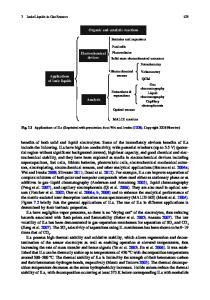Toward more environmentally friendly routes to high purity ionic liquids
- PDF / 501,179 Bytes
- 8 Pages / 585 x 783 pts Page_size
- 15 Downloads / 386 Views
Introduction Room-temperature ionic liquids (RTILs), molten salts at room temperature, are a very interesting new class of neoteric fluids because of their advantages with respect to organic solvents such as non-flammability, undetectable vapor pressure, wide chemical, electrochemical, and thermal stability, and high ionic conductivity. Therefore, RTILs have attracted attention for use as “green” solvents for chemical reactions, biphasic catalysis, and separations1–5 (see the Introductory article in this issue). Also, RTILs have been extensively investigated for applications such as advanced high-temperature lubricants,6 and heat exchanger,7 and transfer fluids in solar thermal energy systems.8 More recently, they have been investigated as electrolytes (or electrolyte components) for the replacement of flammable and volatile organic compounds aiming to realize high safety, electrochemical devices,9–28 including rechargeable lithium batteries, fuel cells, double-layer capacitors, hybrid supercapacitors, and photoelectrochemical cells. However, ILs with the purity levels required for electrochemical applications are not widely available commercially. Therefore, the electrochemistry community has been devoting much effort into obtaining highly pure IL materials. One of the most stringent, if not the most stringent, requirement in designing the synthesis process of ILs is the solvent restriction (e.g., toxicity, volatility, flammability, cost), which has pushed several researchers toward more environmentally friendly process solvents. Finally, in view of near-future
large-scale industrial production, the development of suitable procedures, which allow for the full recycling of the starting chemicals, the solvents, and the purifying materials adopted for the synthesis of ILs is mandatory. In this article, we review the route improvements for synthesizing high purity level ILs in terms of solvent environmental impact, chemical recycling, and cost and process yield.
Synthesis processes of ionic liquids RTILs are constituted of organic (generally asymmetric) tetraalkylammonium (e.g., cyclic (pyrrolidinium, piperidinium)), phosphonium, or heteroaromatic (imidazolium, pyridinium) cations associated with organic/inorganic (symmetric/asymmetric) anions (such as PF6, BF4, per(fluoroalkylsulfonyl)imide).1–5,29,30 The chemical structures of a few of the most common IL cations and anions are depicted in Scheme 1. The great majority of ILs is usually synthesized through a two-stage process: (1) preparation of the precursor salt obtained by N-alkylation of amines using alkyl halides as alkylation agents, and (2) exchange reaction of the precursor halide (halide metathesis) with a suitable anion. However, halide-free synthesis routes, mostly two-step processes, for a wide variety of IL materials are also proposed (see later in the text). Finally, the overall RTIL synthesis processes also include other side steps aimed at enhancing the material purity, including a low water content. Scheme 2 outlines the synthesis steps of a procedure rou
Data Loading...











